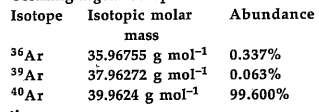use the data given in the following table to calculate the molar mass of naturally occuring argon isotopes.
 Solution in Marathi
Solution in Marathi
Step by step video & image solution for use the data given in the following table to calculate the molar mass of naturally occuring argon isotopes. by Chemistry experts to help you in doubts & scoring excellent marks in Class 11 exams.
Updated on:21/07/2023Similar Questions
निम्न सरणी में दिए गए आकड़ो के प्रयोग, प्रकृतिक रूप से पाए जाने वाले आर्जन के मोलर द्रव्यमान की गणना में कीजिए।

View SolutionUse data given in the following table to calculate the molar mass of naturaly occuring argon isotopes:
IsotopeIsotopic molar massAbundance.36Ar35.96755gmol−10.337%.38Ar37.96272gmol−10.063%.40Ar39.9624gmol−199.600%
(Round of the answer to the nearest whole number ).
View SolutionCalculate the average atomic mass of hydrogen using the following data Isotope % Natural abundance Molar mass .^(1)H 99.985 1 .^(2)H 0.015 2
View SolutionThe average molar mass of naturally occurring Argon. Calculated using the following data is
View SolutionNaturally occuring boron has two isotopes of masses 10 amu and 11 amu. Calculate the percentage of each isotope if the average atomic mass of boron is 10.2.
View SolutionUse data given in the following table to calculate the molar mass of naturaly occuring argon isotopes:
IsotopeIsotopic molar massAbundance.36Ar35.96755gmol−10.337%.38Ar37.96272gmol−10.063%.40Ar39.9624gmol−199.600%
View SolutionUse data given in the following table to calculate the molar mass of naturaly occuring argon isotopes:
IsotopeIsotopic molar massAbundance.36Ar35.96755gmol−10.337%.38Ar37.96272gmol−10.063%.40Ar39.9624gmol−199.600%
(Round of the answer to the nearest whole number ).
View Solution
